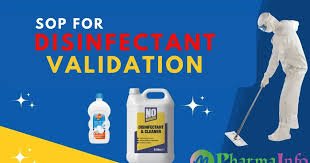SOP for Preparation of Disinfectant Solutions

Standard Operating Procedure (SOP)
1. Purpose
The purpose of this SOP is to establish a standardized process for preparing disinfectant solutions in order to ensure consistency, effectiveness, and safety during disinfection procedures in the manufacturing area, laboratory, or any other relevant environments.
2. Scope
This SOP applies to all personnel responsible for preparing and handling disinfectant solutions used in the facility, including cleaning staff, supervisors, and safety officers. It covers the preparation, dilution, application, and storage of disinfectants.
3. Responsibilities
-
Preparation Personnel: Ensure proper measurement and mixing of disinfectants according to the manufacturer’s instructions and safety guidelines.
-
Supervisors: Oversee the preparation process to ensure the correct concentration and ensure the safety and effectiveness of the disinfectant.
-
Quality Assurance (QA): Validate the disinfectant’s effectiveness and review any adjustments or changes to the solution.
-
Safety Officer: Ensure that proper safety equipment (PPE) is worn during the preparation process and that all safety precautions are followed.
4. Definitions
-
Disinfectant: A chemical agent used to kill or reduce harmful microorganisms on surfaces.
-
Dilution: The process of reducing the concentration of a disinfectant by mixing it with water.
-
PPE (Personal Protective Equipment): Safety gear worn to protect the body from potential hazards, including gloves, goggles, face shields, and lab coats.
5. Procedure
5.1. Selection of Disinfectant
-
5.1.1. Approved Disinfectants: Only use disinfectants approved by regulatory agencies or recommended by the manufacturer for the specific application (e.g., surface disinfection, sanitizing equipment).
-
5.1.2. Active Ingredients: Ensure the disinfectant contains the necessary active ingredients (e.g., bleach, hydrogen peroxide, quaternary ammonium compounds) for effective microbial control.
-
5.1.3. Safety Considerations: Select disinfectants that are safe for the environment and personnel, based on the Material Safety Data Sheet (MSDS).
5.2. Preparation of Disinfectant Solution
-
5.2.1. Determine Required Concentration: Review the disinfectant’s label or MSDS to determine the appropriate dilution ratio (e.g., 1:10, 1:100).
-
Example: For a disinfectant with a recommended dilution of 1:100, use 1 part disinfectant to 100 parts water.
-
-
5.2.2. Gather Equipment:
-
Appropriate measuring equipment (e.g., measuring cups, pipettes, graduated cylinders)
-
Container for mixing (e.g., plastic or glass container suitable for chemicals)
-
PPE (e.g., gloves, goggles, mask, face shield)
-
Stirring implement (e.g., spoon, stir bar, or mechanical stirrer)
-
-
5.2.3. Mixing Procedure:
-
Step 1: Put on the appropriate PPE.
-
Step 2: Measure the required amount of disinfectant.
-
Step 3: Measure the required amount of water (preferably distilled or purified water).
-
Step 4: Slowly add the disinfectant to the water to prevent splashing, unless otherwise instructed. Never add water to concentrated disinfectant, as it may cause an exothermic reaction.
-
Step 5: Stir the solution thoroughly until the disinfectant is completely dissolved and evenly mixed.
-
Step 6: Label the container with the disinfectant name, concentration, date of preparation, and any safety precautions.
-
5.3. Storage of Disinfectant Solutions
-
5.3.1. Labeling: Ensure that each container of disinfectant solution is clearly labeled with:
-
Name of the disinfectant
-
Concentration/ratio
-
Date of preparation
-
Expiry date (if applicable)
-
Handling and safety instructions
-
-
5.3.2. Storage Conditions: Store disinfectant solutions in a cool, dry place away from direct sunlight and extreme temperatures, as these can degrade the disinfectant’s effectiveness.
-
5.3.3. Shelf Life: Disinfectant solutions should be used within a specified time frame to maintain efficacy. Regularly check solutions for signs of degradation (e.g., color change, loss of odor).
5.4. Application of Disinfectant
-
5.4.1. Surface Preparation: Clean the surface to remove any visible dirt or debris before applying the disinfectant.
-
5.4.2. Application Method:
-
Spray, wipe, or immerse surfaces, depending on the type of disinfectant and the surface being cleaned.
-
Ensure adequate contact time as specified on the disinfectant label (typically 1-10 minutes).
-
-
5.4.3. Post-Application: After the required contact time, wipe down surfaces if needed or allow surfaces to air-dry.
5.5. Safety Precautions
-
5.5.1. PPE Usage: Always wear the appropriate PPE (gloves, goggles, face shields, and lab coats) when preparing or applying disinfectants.
-
5.5.2. Ventilation: Ensure the area is well-ventilated to avoid inhaling fumes from concentrated disinfectants.
-
5.5.3. First Aid: In case of contact with eyes or skin, flush immediately with water for at least 15 minutes. If ingested, contact poison control immediately.
6. Health, Safety, and Environmental Considerations
-
6.1. Safety Data Sheets (SDS): Always review the Safety Data Sheets (SDS) for each disinfectant used to understand potential hazards and proper handling.
-
6.2. Waste Disposal: Dispose of any leftover disinfectant solutions or empty containers in accordance with local regulations for hazardous waste.
7. Documentation
-
Keep records of the disinfectant solution preparation, including the disinfectant used, the dilution ratio, date prepared, and the personnel involved. These records should be maintained for a specified period in case of audits or safety inspections.
8. Monitoring and Auditing
-
8.1. Quality Assurance: QA will periodically audit the disinfectant preparation process to ensure adherence to this SOP and verify the effectiveness of the disinfectants used.
-
8.2. Feedback and Improvement: Any issues with the preparation, application, or effectiveness of the disinfectant should be reported, and corrective actions should be taken promptly.
10. Appendices
-
Appendix A: Disinfectant Dilution Chart
-
Appendix B: PPE Guidelines
-
Appendix C: Sample Disinfectant Solution Log
This SOP ensures that disinfectant solutions are prepared, used, and stored in a manner that guarantees safety, efficacy, and compliance with regulatory standards. Regular monitoring and training should ensure that the preparation process is followed consistently.
🎓 Discover one of the best Pharmaceutical Production courses available — click below to explore the course that’s shaping future Production skills.

